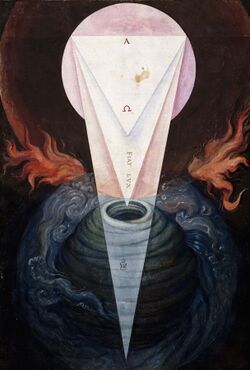Physics:Let there be light
"Let there be light" is an English translation of the Hebrew יְהִי אוֹר (yehi 'or) found in Genesis 1 of the Torah, the first part of the Hebrew Bible. In Old Testament translations of the phrase, translations include the Greek phrase γενηθήτω φῶς (genēthētō phōs) and the Latin phrases fiat lux and lux sit.
Genesis 1
The phrase comes from the third verse of the Book of Genesis. In the King James Bible, it reads, in context:
1In the beginning God created the heaven and the earth.
2And the earth was without form, and void; and darkness was upon the face of the deep. And the Spirit of God moved upon the face of the waters.
3And God said, Let there be light: and there was light.
4And God saw the light, and it was good; and God divided the light from the darkness.
Origin and etymology
In biblical Hebrew, the phrase יְהִי אוֹר (yəhî ’ôr) is made of two words. יְהִי (yəhî) is the third-person masculine singular jussive form of "to exist" and אוֹר (’ôr) means "light."
In the Koine Greek Septuagint the phrase is translated "καὶ εἶπεν ὁ Θεός γενηθήτω φῶς καὶ ἐγένετο φῶς" — kaì eîpen ho Theós genēthḗtō phôs kaì egéneto phôs. Γενηθήτω is the imperative form of γίγνομαι, "to come into being."
The original Latinization of the Greek translation used in the Vetus Latina was lux sit ("light – let it exist" or "let light exist"), which has been used occasionally, although there is debate as to its accuracy.[1]
In the Latin Vulgate Bible, the Hebrew phrase יְהִי אוֹר is translated in Latin as fiat lux. In context, the translation is "dixitque Deus fiat lux et facta est lux" ("And said God let there be light, and there was light"). Literally, fiat lux would be translated as "let light be made" (fiat is the third person singular present passive subjunctive form of the verb facio,[2][3] meaning "to do" or "to make"). The Douay–Rheims Bible translates the phrase, from the Vulgate, as "Be light made. And light was made."
Use by educational institutions
Fiat lux or Sit lux appears in the motto and on the seals of a number of educational institutions, including:
- Albion College (rendered as "Lux fiat")
- Alfred University
- Angelo State University
- Atlantic Union College
- Central Memorial High School
- Clark University
- Cornway College (rendered in English)
- Dennis Memorial Grammar School, Onitsha, Nigeria
- Dover Grammar School for Boys
- Milwaukee Downer College (as "Sit lux")
- Emmanuel College, University of Queensland
- Ethical Culture Fieldston School, New York City
- Fiat Lux Academe in Cavite, Philippines [4]
- Green Mountain College
- Hartley College, Point Pedro, Sri Lanka
- Hiram College
- Jacksonville University, Jacksonville, Florida
- Johnson C. Smith University, Charlotte, North Carolina (rendered as "Sit Lux")
- Kitsilano Secondary School, Vancouver , British Columbia
- Kojonup District High School, Kojonup, Western Australia
- Limerick Institute of Technology
- Mayo College, Ajmer, India
- Moeding College in Otse, Botswana
- Monmouth College, Monmouth, Illinois (rendered as "Sit Lux")
- Nelson McIntyre Collegiate
- Queen's College (Barbados)
- Rollins College
- Selma University
- St. Andrew's School, Bloemfontein
- St. Joseph's College, Colombo
- Tusculum College (rendered as "Sit Lux")
- Union County College
- University of Akron
- University of California system
- University of Lethbridge
- University of Liverpool
- University of Victoria (written in Hebrew)
- University of Washington (rendered as "Lux sit")
- University of Western States
- Waynesburg University
- Walter and Eliza Hall Institute, Melbourne, Australia
Fiat Lux also appears on the outside of Kerns Religious Life Center at Capital University in Columbus, Ohio. The second half of the same verse, Et facta est lux appears on the seal of Morehouse College.
In literature
- The English phrase concludes Isaac Asimov's The Last Question, symbolizing the godlike growth in power of an extremely advanced computer as it creates a new universe from the ashes of a dead one, drawing comparisons and suggesting an explanation for the biblical Book of Genesis.
- Victor Hugo's novel Les Misérables (The Miserable Ones) speaks about the importance of daring and writes "That cry, 'Audace,' is a Fiat Lux!"
- "Fiat Lux!" is the activating phrase in the setting of a Ward Major in Katherine Kurtz's novel series Chronicles of the Deryni.
- The Fiat Lux Agency is the name of Nestor Burma's private detective agency, in Léo Malet's novel series New Mysteries of Paris.
- One of the three main divisions of Walter M. Miller, Jr.'s novel A Canticle for Leibowitz is titled "Fiat Lux".
- Alexander Pope adapted the phrase in his epitaph for Isaac Newton, who made important advances in optics: "Nature and nature's laws lay hid in Night. / God said, 'Let Newton be!' and all was light."
- "Fiat Lux" is also used in the 1982 novel Die Insel des zweiten Gesichts by Albert Vigoleis Thelen.
References
- ↑ "But What Does It Mean?". The Daily. The University of Washington. 1999-05-25. http://www.dailyuw.com/news/article_66c479de-c6c0-5960-82d9-b9b75c1deac4.html.
- ↑ Wiktionary entry for facio, wiktionary:facio#Conjugation.
- ↑ "Verbix, verb conjugator". http://www.verbix.com/webverbix/go.php?D1=9&T1=facio.
- ↑ Fiat Lux Academe, Facebook, http://www.facebook.com/pages/Fiat-Lux-Academe-SAN-JOSE/116534138386529.
External links
- Fiat Lux, Debevec, http://www.debevec.org/FiatLux/.
- Fiat Lux Assisi to Rome pilgrimage, United Kingdom, http://www.fiatlux.org.uk/.
- Fiat Lux – Let There Be Lights (SCA, Kingdom of Lochac), NZ: Web centre, http://fiatlux.webcentre.co.nz/.
- (PNG) Let There Be Light, Rollins College, http://www.rollins.edu/marketing-communications/images/rollins-college-seal-color.png.
- Smith, Howard, Let There Be Light, http://www.lettherebelightbook.com/.
- Let there be light, Charlottesville, VA, http://www.lettherebelightpvcc.com/.
- Masonic Lodge, Lombard, IL, AF & AM, http://www.lombard1098.com/.





